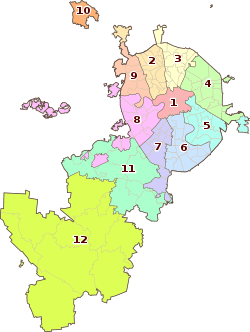Kitay-gorod
Kitay-gorod (Russian: Китай-город, IPA: [kʲɪˈtaj ˈɡorət]), also referred to as the Great Possad (Russian: Великий Посад) in the 16th–17th centuries, is a cultural and historical area within the central part of Moscow in Russia, defined by the remnants of now almost entirely razed fortifications, narrow streets and very densely built cityscape. It is separated from the Moscow Kremlin by Red Square. Kitay-gorod does not constitute a district (raion), as there are no resident voters, thus, municipal elections are not possible. Rather, the territory has been part of Tverskoy District, and the Central Administrative Okrug authorities have managed the area directly since 2003.
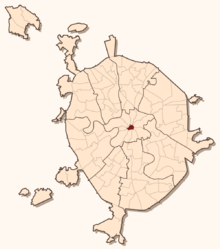
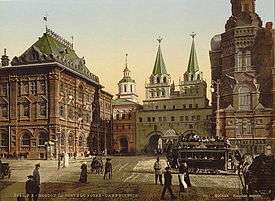
Etymology
The origins of the name Kitay-gorod are unclear. Gorod is the Russian word for "city", derived from the ancient gord.[1]
Kita (pl. kity) is a somewhat obsolete word for "plait" or "an item made by braiding". A 17th-century Russian source states "У шапок янычары имели киты" ("U shapok yanychary imeli kity"), meaning "The Janissaries had braids hanging from their caps". Author Robert Wallace asserts in his 1967 book Rise of Russia the term might mean a rough-hewn defensive bulwark made from woven wicker baskets filled with earth or rock – and thus Kitay-gorod means "Basket city". Kitay could also be derived from an old word for the wooden stakes used in construction of the quarter's walls.
Walls
The walls were erected from 1536 to 1539 by an Italian architect known under the Russified name Petrok Maly and originally featured 13 towers and six gates. They were as thick as they were high, the average being six meters in both dimensions. The last of the towers were demolished in the 1930s, but small portions of the wall still stand. One of two remaining parts of the wall is located in Zaryadye and the other near the exit from the Okhotny Ryad station of Moscow Metro behind the Hotel Metropol.
Recently the mayor of Moscow announced plans for a full-scale restoration of the wall. City officials also plan to close Kitay-gorod to automobile traffic. Since 1995 the wall has been extensively rebuilt, and a new tower has been added. Inside the tower are a couple of restaurants and bars.
Squares
Apart from Red Square, the quarter is bordered by the chain of Central Squares of Moscow, notably Theatre Square (in front of Bolshoi Theatre), Lubyanka Square (in front of the KGB headquarters), and Slavyanskaya Square. Bourse Square on Ilyinka Street is situated entirely within Kitay-gorod.
Architecture
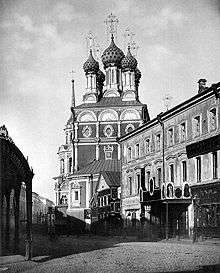
Kitay-gorod, developing as a trading area, was known as the most prestigious business area of Moscow. Its three main streets — Varvarka, Ilyinka, and Nikolskaya — are lined with banks, shops, and storehouses like the historicistic shopping mall GUM which confines Kitay-gorod towards Red Square.
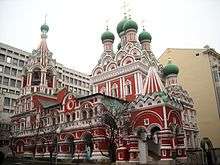
One of the most beautiful churches in Moscow, St. Nicholas Church on the Ilyinka (1680–89), informally known as the Great Cross, was a landmark in Kitay-gorod but was destroyed in 1933.[2] This district also features the Church of Cosmas and Damian and the Trinity Church of Nikitniki, which today is nestled among city buildings. It was built in the 1630s on the land of Moscow merchant, Grigory Nikitnikov.[3]
Nikolskaya Street is famous for being the site of Moscow's first university, the Slavic Greek Latin Academy, housed in extant Zaikonospassky monastery (1660s). Another monastery cathedral, the main church of Epiphany Monastery (1690s), stands in the middle of Kitay-gorod in the eponymous Bogoyavlensky Lane. The 18th century survives in the exterior walls of the otherwise rebuilt Gostiny Dvor (Guest Merchant's Court) by Giacomo Quarenghi.
In the 19th century, Red Square was lined by a neoclassical domed structure of Upper Trade Rows by Joseph Bove. However, in the 1890s it was torn down and replaced with the new, eclectic Upper Trading Rows (by Alexander Pomerantsev and Vladimir Shukhov) and the similar Middle Trading Rows (by Roman Klein). The rest of Kitay-gorod was densely filled with offices, warehouses and hotels, to the point where real estate developers had to build streets, not buildings – like the Tretyakovsky Proyezd project by Pavel Tretyakov and Alexander Kaminsky.
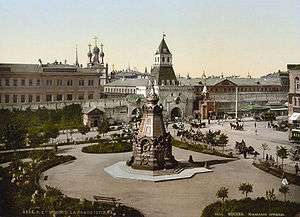
Also in the 1890s, developers consolidated large land lots on the perimeter of Kitay-gorod. Savva Mamontov launched an ambitious civic center, built around an opera hall, which was completed as the Metropol Hotel in 1907, the largest early Art Nouveau building in Moscow, containing artwork by Mikhail Vrubel, Alexander Golovin and Nikolai Andreev. The eastern segment (Staraya Square) was rebuilt by the Moscow Merchant Society, with the late Art Nouveau Boyarsky Dvor offices (by Fyodor Schechtel) and the neoclassical 4, Staraya Square (by Vladimir Sherwood, Jr., 1912–1914) which later housed the Central Committee of the Communist Party.
The present-day offices and clock tower of Constitutional Court of Russia were financed by the Northern Insurance Society (1910–1912) and built by Ivan Rerberg, Marian Peretiatkovich and Vyacheslav Oltarzhevsky; this project is also notable as the first professional employer of young Ilya Golosov.
Since the early 1990s, many historical buildings have been torn down or rebuilt by facadist methods, tearing down everything beyond the street facade. Apart from the Gostiny Dvor, recent losses include the Tyoplye Trade Rows (Теплые ряды, demolished 1996–1997) and the recently reopened block at 10, Nikolskaya Street. The degree of destruction cannot be assessed in full, since many properties are operated by the federal government and closed to the general public.
Zaryadye
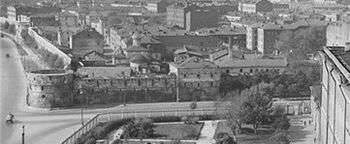
A whole quarter of Kitay-gorod[4] adjacent to the Moskva River and known as Zaryadye was demolished in three rounds (1930s, late 1940s, 1960s), sparing only those structures that were classified as historic monuments. These include the Cathedral of the Sign (1679–84), the Church of All Saints (1680s), St. George's Church on Pskov Hill (1657), St. Maksim's Church (1698), St. Anna's Church at the Corner (1510s), St. Barbara's Church (1796–1804), the Old English Embassy (1550s), and the 16th century Romanov boyar residence. There is no other such cluster of old edifices left anywhere else in Moscow. The district's main structure, Rossiya Hotel (1967), was demolished in 2007 to make space for the new Zaryadye Park which was opened in 2017.
Gallery
 A 1922 painting by A. Vasnetsov, depicting a street in Kitay-gorod in the 17th century
A 1922 painting by A. Vasnetsov, depicting a street in Kitay-gorod in the 17th century A. Vasnetsov. Spasskiye/Wodyaniye (Savior/Water) gates of Kitay-gorod in the 17th century
A. Vasnetsov. Spasskiye/Wodyaniye (Savior/Water) gates of Kitay-gorod in the 17th century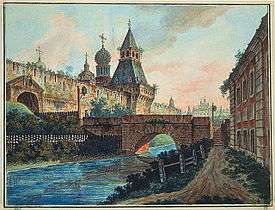 Nikolskiye (St. Nikolay's) Gates and breaching gates, c. 1800
Nikolskiye (St. Nikolay's) Gates and breaching gates, c. 1800 Novaya square, c. 1800
Novaya square, c. 1800 Ilyinskye (St. Elijah's) gates, 1840s
Ilyinskye (St. Elijah's) gates, 1840s Nikolskiye/Vladimirskiye (St. Nikolay's/St. Vladimir's) Gates, 1840s
Nikolskiye/Vladimirskiye (St. Nikolay's/St. Vladimir's) Gates, 1840s Varvarskye (St. Barbara's) gates
Varvarskye (St. Barbara's) gates Nikolskiye/Vladimirskiye Gates and Lubianka Square, 1880
Nikolskiye/Vladimirskiye Gates and Lubianka Square, 1880 Restoration of Kitay-gorod wall in the 1920s
Restoration of Kitay-gorod wall in the 1920s Kitai-gorod wall in Zaryadye
Kitai-gorod wall in Zaryadye Breaching gates in Zaryadye
Breaching gates in Zaryadye.jpg) The Old English Court
The Old English Court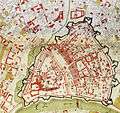 Old map of the Kitay-gorod showing the walls in black
Old map of the Kitay-gorod showing the walls in black
References
| Wikimedia Commons has media related to Kitai-gorod. |
- Zubacheva, K. (2020-01-17). "Moscow has its own Chinatown, but it's not what you think". Russia Beyond the Headlines. Retrieved 2020-01-29.
- "St. Nicholas Church Ilyinka". St. Nicholas Center.
- "The Church of the Holy Trinity in Nikitniki".
- "Kitay-gorod is a historical part of Moscow".
